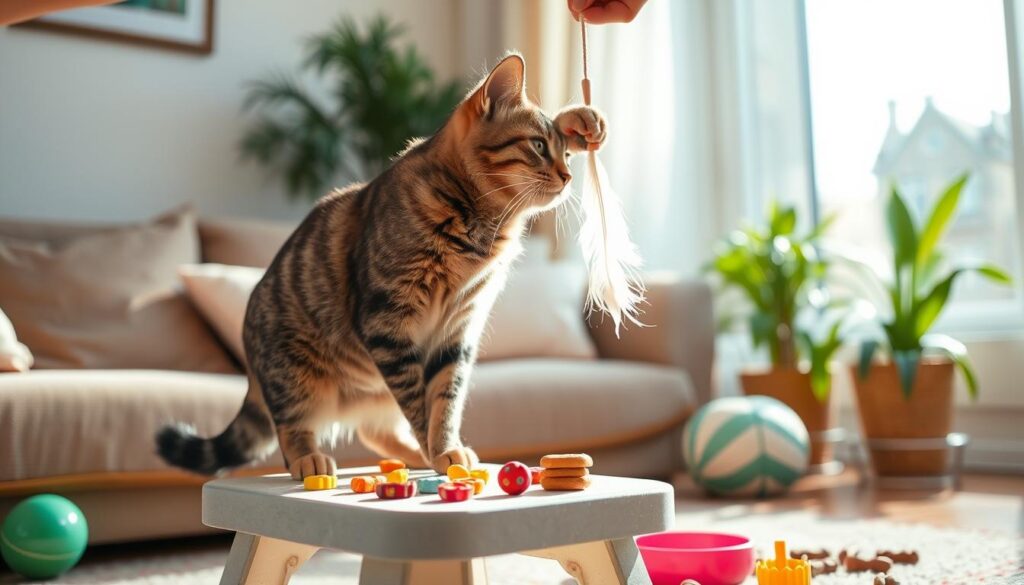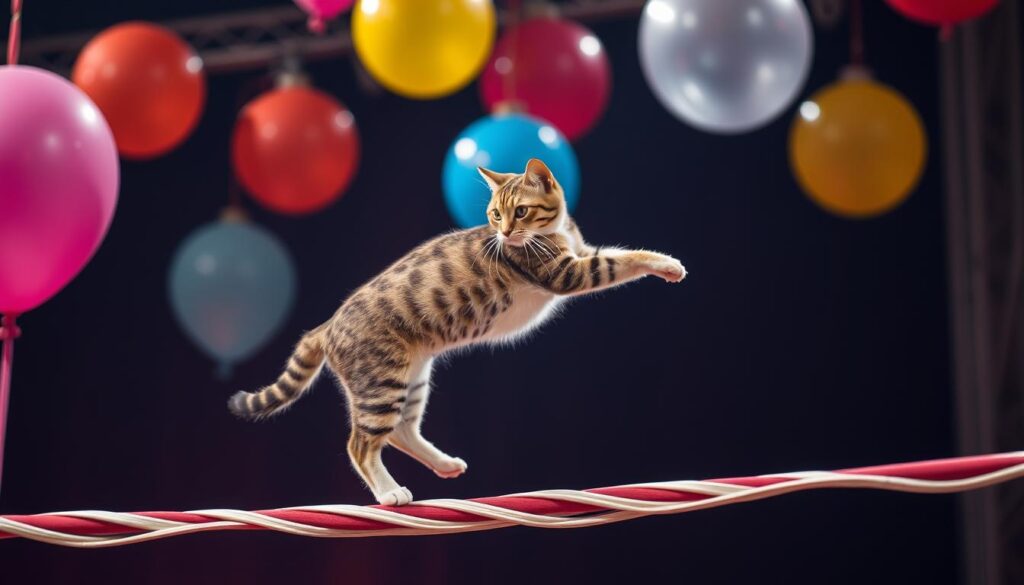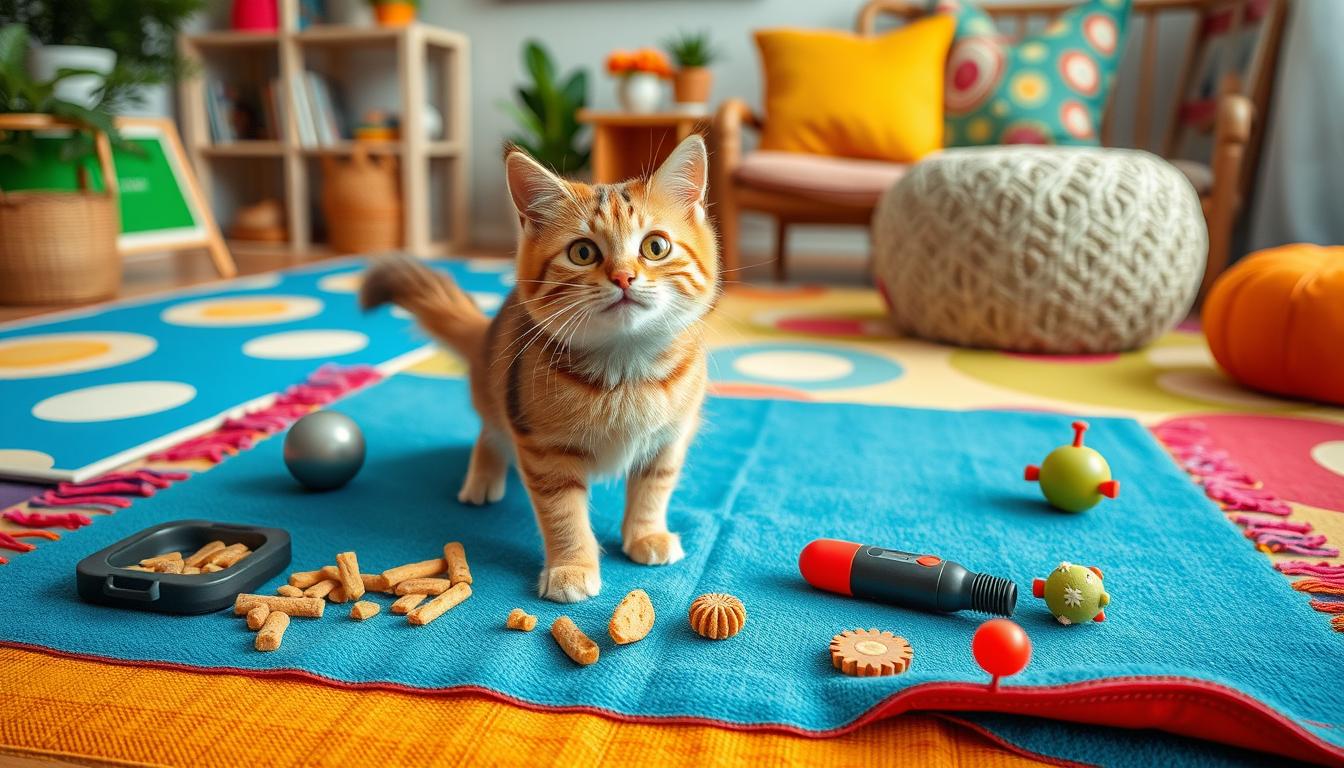Cats can learn many tricks and commands. A study showed over 70% of cat owners have taught their cats new things. They use positive methods like clicker training.
This shows cats can learn a lot. It also makes the bond between cats and owners stronger. Plus, it keeps the cat’s mind active.
Table of Contents
Understanding Cat Behavior
To train your cat well, you must know how they think and act. Cats are not like dogs, who live in packs. Cats like to do things on their own and don’t always want to please us. Knowing this helps us train them better.
The Science of Feline Learning
Cats learn by doing things and seeing what happens next. They remember a lot and can learn hard things. Giving them treats or praise works best, not yelling at them.
Key Differences Between Dogs and Cats
- Cats are more independent and less motivated by pleasing their owners, unlike dogs who are pack animals.
- Feline learning is often driven by self-interest rather than a desire to obey commands.
- Cats respond better to positive reinforcement, such as rewards, than to punishment.
- Cats have excellent memory and can learn complex behaviors, but their training progress may be slower than that of dogs.
Knowing how cats think and learn helps us train them better. It makes training fun for both us and our cats.
“Cats are not dogs – they have their own unique way of learning and responding to training. Recognizing and respecting these differences is key to successful cat training.”
Understanding how cats learn helps us train them right. It also makes our bond with them stronger. Training them with treats and praise is the best way.
Why Train Your Cat?
Cats can be trained, and it’s very beneficial. Training goes beyond just tricks. It gives your cat mental stimulation and keeps them from getting bored.
By training your cat, you help them get used to new things. This includes vet visits and meeting new pets. It makes them more comfortable and adaptable.
Benefits of Cat Training
- Enhances mental stimulation and reduces boredom, preventing associated behavioral problems
- Improves socialization skills, making cats more adaptable to new environments and experiences
- Facilitates easier handling during veterinary appointments or when introducing new pets
Enhancing the Human-Cat Bond
Training your cat can make your bond stronger. You learn more about what your cat needs and how they communicate. This makes your relationship better and more rewarding.
Working together on training goals builds trust. It creates a deeper emotional connection between you and your cat.

“Training your cat not only offers practical benefits, but it can also be a deeply rewarding experience for both you and your feline companion.”
Preparing for Training Sessions
Creating a positive, cat-friendly space is key for good training with your cat. Pick a quiet, place with no distractions. This lets your cat focus better. Training in the same spot every time helps a lot.
For the training schedule, pick times when your cat is most active. This is often after eating or playing. Keep each session short, 5-10 minutes. This keeps your cat interested. As your cat gets used to it, you can make sessions longer.
- Make sure there are no distractions like toys or other pets.
- Choose a quiet, comfy spot that your cat likes.
- Train when your cat is most awake, like after meals or play.
- Keep each session short to keep your cat’s attention.
- Training in the same place and time helps a lot.
By making a positive, structured space and sticking to a schedule, you’re ready for great training sessions with your cat.
“The key to successful cat training is to make it a positive, enjoyable experience for your cat. Create a calm, cat-friendly space and stick to a consistent training schedule to build trust and engagement.”
Tools and Supplies for Cat Training
Good cat training needs the right tools and supplies. You’ll need things like training aids and treats to keep your cat interested and eager to learn.
Essential Training Tools
A clicker is a key tool for cat training. It uses rewards to teach your cat new things. When you click, you reward your cat for good behavior.
You’ll also need interactive toys. These toys make training fun. They help your cat learn while playing.
Treats and Rewards: What Works Best
Choose small, tasty cat treats for rewards. Freeze-dried meat or cooked chicken works well. Find treats your cat loves most.
Not all cats like treats. Some prefer play or affection. Try different rewards to see what your cat likes best.
“The key to successful cat training is having the right tools and supplies on hand. With the proper rewards and equipment, you can help your feline friend learn new behaviors and strengthen the bond between you.”
Basic Commands You Can Teach Your Cat
Cats can learn many basic commands. They can be trained with patience and positive rewards. You can teach them to “sit,” “stay,” “come,” and even “high five.”
These tricks make your bond stronger. They also improve your cat’s obedience and how well they listen to you.
Teaching “Sit” and “Stay”
The “sit” command is a good first step in cat obedience training. Hold a treat near your cat’s nose. Slowly move it up to their forehead. This makes them sit to follow the treat.
Once they learn “sit,” teach them “stay.” Start with short times and reward them right away. Then, increase the time and distance before giving the treat. This helps them learn to stay patiently.
Training for “Come” and “High Five”
Teaching your cat to “come” is very useful. Use their name and “come” while offering a treat. Over time, stop using treats and just praise them for coming.
“High five” is another fun command to teach. Hold a treat above your cat’s head. Lower it to your hand, and reward them when they touch their paw to yours.
Remember, practice, positive rewards, and patience are important. Learning these commands will impress your friends and make your bond with your cat even stronger.
Advanced Tricks for Savvy Cats
Basic commands like “sit” and “stay” are cool for cats. But, why not try something more? Teach your cat cool tricks that will wow everyone.
Teaching Your Cat to Fetch
Fetch is not just for dogs. Cats can learn it too. Start with a light toy, like a small ball. When they bring it back, give them a treat or praise.
Make the game harder as they get better. This will keep them interested and learning.
How to Train Your Cat to Use a Litter Box
Teaching your cat to use the litter box is a big deal. Start by putting them in the box after meals. Reward them when they do it right.
If they have accidents, gently show them the box. Keep praising them for good behavior. Soon, they’ll see the litter box as a good place to go.
Teaching cats advanced tricks needs patience and effort. Break big tasks into smaller steps. This way, you won’t get frustrated with your cat. With time and effort, they’ll learn amazing tricks.

“Training your cat to perform advanced tricks takes time and patience, but the bond you’ll build with your furry companion is well worth the effort.”
| Trick | Description | Difficulty Level |
|---|---|---|
| Fetch | Teach your cat to chase and retrieve a toy | Moderate |
| Litter Box Training | Train your cat to consistently use the litter box | Moderate to Advanced |
| Agility Course | Guide your cat through a custom-made obstacle course | Advanced |
| Open Door | Teach your cat to open a door on command | Advanced |
Common Misconceptions About Cat Training
Many think cats can’t be trained. But, cats can learn tricks and behaviors with the right methods. It’s all about understanding cat training myths, feline independence, and trainability of cats.
Cats Are Untrainable: Myth or Reality?
Cats are not completely untrainable. Owners can teach them tricks with patience and positive rewards. Cats might not always listen like dogs, but they can learn and remember important behaviors.
Understanding Kitty Independence
- Cats are solitary hunters and prefer to work at their own pace, unlike the pack-driven nature of dogs.
- They are motivated by food, play, and affection, rather than a desire to please their human companions.
- Recognizing and catering to a cat’s natural inclinations is key to successful training.
Adapting training to a cat’s independent nature can unlock their potential. This way, owners can enjoy a well-trained and happy cat.
“The greatest trick a cat can teach us is how to live a life of complete independence and contentment.”
Positive Reinforcement Techniques
Training cats works best with positive reinforcement. Cats like rewards more than punishments. This makes them learn better.
Clicker Training Explained
Clicker training uses a special device that makes a click sound. It marks good behaviors. Then, a treat or playtime follows the click.
This way, cats know what they did right. They learn fast.
Types of Treats That Motivate Cats
- Commercial cat treats
- Small pieces of cooked meat or fish
- Catnip or other favorite toys
Try different rewards to see what your cat likes best. Some cats prefer play or hugs over treats.

“Positive reinforcement is key to successful cat training. By rewarding desirable behaviors, you can encourage your feline friend to learn new tricks and commands with ease.”
Being consistent is very important. A routine helps your cat learn faster. It makes training fun for both of you.
Troubleshooting Training Challenges
Teaching cats new tricks can be tough. They might get distracted easily or have short attention spans. But, with patience and the right method, even stubborn cats can learn.
Dealing with Distractions
Cats often get distracted, making training hard. Start in a quiet place and add distractions slowly. Keep sessions short and fun, adjusting as needed.
When Your Cat Is Unresponsive
If your cat doesn’t seem to care about training, try something new. Use better treats or playtime as rewards. Also, start with simpler tricks.
| Common Cat Training Problems | Overcoming Training Obstacles | Maintaining Feline Attention Span |
|---|---|---|
| Short attention span | Start in a quiet environment | Keep training sessions short and engaging |
| Easily distracted | Gradually introduce distractions | Use high-value treats as rewards |
| Unresponsive to training | Try different reward systems | Incorporate playtime as reinforcement |
Every cat is different. Be patient and try various methods to find what works for your cat.
“Patience is key when training cats. Some may take longer to learn certain behaviors, but with the right motivation and a positive approach, you can teach even the most stubborn cat new tricks.”
Alternative Training Methods
Traditional treat-based training works well for many cats. But, there are other ways to train them too. Hand signals and play-based learning are two great options.
Using Hand Signals
Cats love non-verbal cat training cues. Hand signals are a great tool. They help cats learn by seeing what you want.
Start with simple commands like “sit” or “come.” Use a special hand gesture with each command. Reward your cat when they do it right. Soon, they’ll know what you mean just by looking at your hands.
Incorporating Play as Training
Play-based learning for cats makes training fun. Use toys and play to teach your cat. It’s a way to use their natural hunting skills.
- Use toys like wands or laser pointers to guide your cat. Reward them with play when they do what you want.
- Play with your cat before training. This helps them focus and have fun.
- Play with your cat when they do well. This makes them happy and teaches them.
Remember, being consistent and patient is key. Non-verbal cat training and play-based learning for cats work well. They help your cat learn and strengthen your bond.
The Role of Consistency in Training
Teaching your cat new tricks needs consistency. A regular training schedule is key. Use the same cues and rewards always.
Establishing a Routine
Cats love routine. Adding training to your daily life helps a lot. Short, frequent sessions work best.
Tracking Progress and Adjustments
Watching your cat’s progress is important. See what works best for them. Change your methods if needed.
Consistent training is more than a schedule. It’s about a positive, rewarding space for your cat. Routines, tracking, and adjustments help your cat learn and grow.
Final Thoughts on Training Your Cat
Starting your cat’s training is exciting. Every small success is worth celebrating. Cats learn at their own speed, and it’s okay if it takes time.
Enjoy it when your cat learns something new. These small wins help you and your cat grow closer.
Celebrating Small Wins
Positive reinforcement is very important. Give your cat lots of praise, treats, and love when they do well. This makes them want to learn more.
It also makes your bond stronger. You and your cat will understand each other better.
Continuous Learning for You and Your Cat
Training is a journey for both you and your cat. Keep finding new things to teach your cat. This keeps their mind active.
Learn about the latest in cat behavior and training. This helps you keep your cat’s training fun and effective. It also helps improve their behavior and your bond.


2 thoughts on “Can You Really Teach a Cat New Tricks?”
Comments are closed.